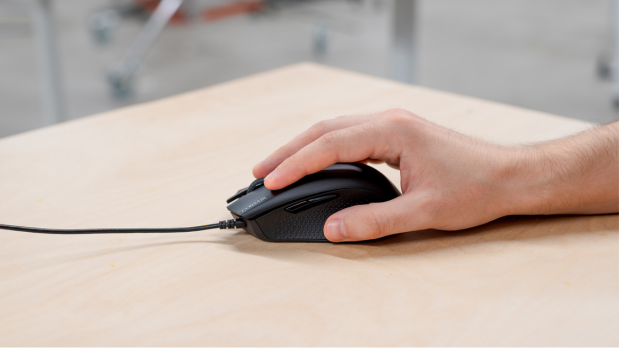Mouse DPI, or dots per inch, is a measurement used to determine the sensitivity of a mouse.
This is important for gamers or other users that need precise mouse movements to achieve the highest accuracy when playing games or performing work.
If a mouse is not working properly, it may be due to issues with hardware, drivers, software, or connectivity.
A Mouse Test is a tool designed to analyze mouse-related problems, test various aspects of mouse performance, and provide detailed reports on mouse behavior.
A higher DPI means the mouse is more sensitive and requires less movement for the same cursor speed on the screen.
On the other hand, a lower DPI means the mouse is less sensitive and requires more movement for the same cursor speed on the screen.
Checking a mouse’s DPI is fairly simple, and can be done in just a few ways on Windows 10.
To check mouse DPI, users can use the Mouse Properties window or the Settings app.
What Are The Steps To Check The DPI Of A Mouse In Windows?

If you don’t have the manufacturer software installed or if it doesn’t display the DPI settings, you can still check your mouse DPI using the Windows settings in Windows 10/11. Here are the steps to follow:
- Open the Windows settings by pressing the Windows key + I.
- Click on “Devices.”
- Click on “Mouse” in the left pane.
- Scroll down to the “Related settings” section and click on “Additional mouse options.”
- Click on the “Pointer Options” tab.
- Under the “Motion” section, you’ll see a slider labeled “Pointer speed.” Make a note of the current position of the slider.
- Move your mouse a known distance, such as one inch, and measure how far the mouse pointer moves on the screen.
Other Ways To Check Mouse DPI
1. Check DPI Via Mouse Driver Software
Mouse sensitivity is directly related to DPI or dots per inch. The DPI of the mouse determines its sensitivity and the amount of movement and control required.
It enhances the performance in games where more precise control is required. On the other hand, lower DPI settings can reduce mouse sensitivity, making it easier to make larger movements with the same amount of effort.
2. Using MS Paint
To test your mouse’s sensitivity in Microsoft Paint, open the program, then press and hold the left mouse button while dragging the cursor across the screen.
If your mouse is highly sensitive, you will find that the cursor moves across the screen very quickly.
If your mouse is less sensitive, you will find that it takes more effort to move the cursor across the screen.
From this test, you can adjust your mouse’s sensitivity by increasing or decreasing the DPI using the slider in the Control Panel.
3. DPI Analyzer Tool
The DPI Analyzer tool is a great way to measure your mouse sensitivity. This tool measures the accuracy of your mouse movements and is useful for determining the best settings.
To use this tool, you will need to install it on your computer. Once it is installed, launch the application and follow the on-screen instructions to measure your mouse movements.
Measure The Mouse DPI Manually

If you want to measure your mouse sensitivity manually, you can do so by using a wrist ruler. Place the ruler on the mousepad, then move the mouse cursor up and down the ruler.
As you move, check the distance the cursor has moved in relation to the ruler. By measuring the distance, you can calculate the DPI of your mouse.
Ultimately, your mouse sensitivity is a personal preference and depends on how you will use it.
If you are a gamer, you may need a higher sensitivity to make quick movements in-game.
On the other hand, if you are an artist or graphic designer, you may need a lower sensitivity to be able to make precise and detailed movements.
Experiment with different sensitivities to find out which one works best for you.
Mouse Sensitivity (DPI) Settings
Adjusting your mouse sensitivity, or DPI can be done in the settings menu of your mouse. Most gaming mice will have some built-in presets, as well as the ability to adjust the sensitivity manually.
On most modern mice you can also adjust the polling rate, or how often the mouse communicates with the computer.
This can be adjusted to reduce lag in gaming and increase accuracy in precision tasks.
The correct settings depend on the task at hand and the user’s individual preferences. Higher sensitivity is often favored by gamers as it allows for quick movements and reactions.
While lower sensitivity is often favored by artists and graphic designers as it allows for more precise and detailed movements.
Ultimately, there is no one “right” setting and it is up to the user to experiment with different settings to find out which one works best for them.
How To Adjust The DPI Settings Of My Mouse For Gaming?

To adjust the sensitivity of your mouse for gaming, you must first access the settings menu. This can usually be done by pressing the button on the mouse or through the mouse software.
Once you’re in the settings, you can select one of the preset sensitivities or adjust the settings manually.
It’s important to experiment with different sensitivity levels to find what’s right for you.
You may want to start with a lower-sensitivity setting and move up until you find the one that is most comfortable for you.
Remember, the higher the DPI, the more sensitive your mouse will be. This can be beneficial in certain cases, such as Fast-Paced Shooters, but it may have a negative effect on your more precise aiming.
It’s important to find a balance between speed and accuracy, and this goes for all aspects of gaming, not just the mouse settings.
FAQs
Can You Check My Mouse DPI Using Third-Party Software?
The answer is yes. There are a few different pieces of free software available that allow users to check their mouse DPI.
It is important to note that these programs can give a relatively accurate reading, but may not match the exact DPI setting of the mouse.
This is because some mice are designed to have their DPI settings changed on the fly, without any software required.
Can You Find The DPI Of My Mouse On The Manufacturer’s Website?
Yes, you can typically find the DPI of your mouse on the manufacturer’s website. However, it is important to note that the exact setting may vary depending on the specific model and make of the mouse.
Additionally, some mice may have the ability to adjust their DPI settings without the need for any Third-Party software, so it is best to consult with the manufacturer’s website or customer support if you are unsure.
Lastly, if you are looking to purchase a new mouse, it is a good idea to look at the features and specifications available so that you can make an informed decision.
How Is Mouse Sensitivity Related To DPI?
Mouse sensitivity is related to DPI in that the higher the DPI, the more sensitive the mouse will be.
This means that the mouse cursor will move farther with less movement of the mouse itself.
Therefore, if you have a mouse with a high DPI, you will need to make smaller movements to achieve the same movement on the screen.
On the other hand, if you have a mouse with a low DPI, you will need to make larger movements for the cursor to move the same distance on the screen.
Final Words
Knowing your mouse’s DPI is important if you want to adjust the sensitivity of your mouse to match your needs.
You can check your mouse DPI using the manufacturer’s software or by using the Windows settings.
By following the steps outlined in this blog post, you’ll be able to find out your mouse DPI and make any necessary adjustments.





